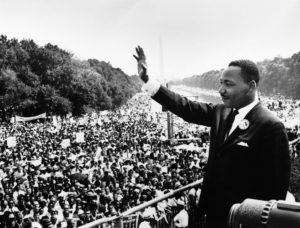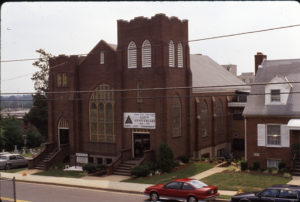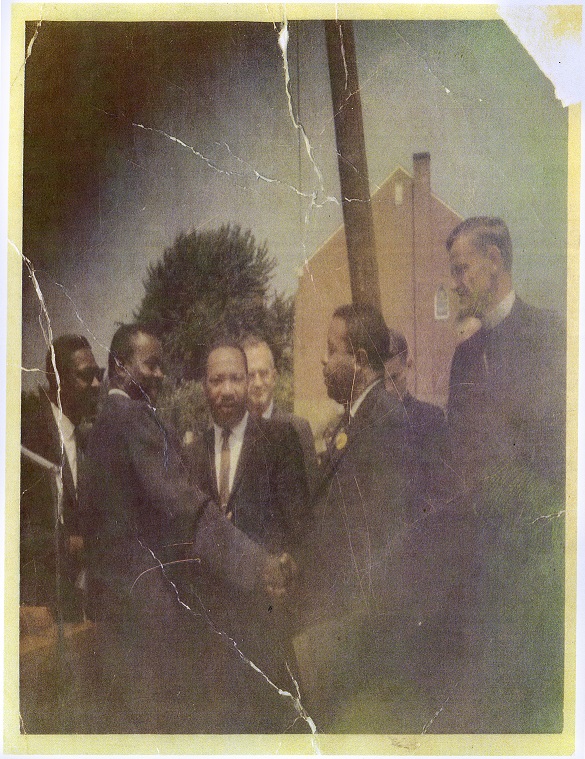A Crucial Leader of the Civil Rights Movement
Dr. Martin Luther King's leadership and message of nonviolent protest were essential to the steps made toward equality that culminated in legislation such as the Civil Rights Act of 1964. The following are a few memories from our collections, and from broader Arlington history, to reflect on Dr. King’s legacy as we celebrate Martin Luther King, Jr., day on Monday, January 17th.
Dr. King addresses the crowd at the August 28, 1963, March on Washington. Image courtesy of Wikimedia Commons.
1963 March on Washington
On Wednesday, Aug. 28, 1963, Dr. King led the March on Washington for Jobs and Freedom — often referred to as “The March on Washington."
This was a massive peaceful protest with the aim to advocate and speak on the need for economic and civil rights for Black Americans, with more than 200,000 people attending to take a stand against inequality. The march culminated with Dr. King’s “I Have a Dream Speech” on the steps of the Lincoln Memorial.
In the days leading up to the march, civil rights activists from across the country stayed at Lomax Fellowship Hall at the Lomax AME Zion Church in Arlington’s Green Valley neighborhood. Dr. King and his close friend and advisor, the Reverend Ralph Abernathy, spoke in the church’s parking lot the day before the start of the march.
In the following interview from our oral history collection, Marionne Walls-Fort discusses Dr. King’s visit to Lomax. Walls-Fort is the daughter of Reverend Arthur W. Walls, who was a pastor at Lomax from 1960-1976.
Narrator: Marionne Walls-Fort
Interviewer: Judy Knudsen
Date: October 7, 2016
Marionne Walls-Fort: "My parents were very influential in keeping us together in the civil rights movement. In fact, Dr. Martin Luther King spoke in the back of Lomax. When he was coming, he was looking for a church in Virginia, and my father volunteered. So he did one of his speeches in the backyard, because there’s a large back area behind Lomax Church. We got to meet Dr. Martin Luther King, and of course, Jesse Jackson who also spoke at our church for equal rights.
Dad had the Poor People’s March, when they came [in 1968]—and they would travel from church to church—we had them to stay overnight in our church. So when Dad said we’re going to help, we’re going to help get these cots together, we’re going to help in feeding the poor, we did everything as a family. And that instilled in all of us a sense of service even today that was instilled in our hearts, and that’s what we grew up with."
Dr. Martin Luther King Jr., and Reverend Ralph Abernathy with members of the Lomax AME Zion Church and Father Ray from Our Lady Queen of Peace on August 27, 1963. This photo is from Record Group 328, comprising the archives of Lomax AME Zion Church which were donated to the Center for Local History in 2020.
In another oral history interview, Arlington resident Jackie Smith discusses attending the March on Washington along with other members of Our Lady Queen of Peace Roman Catholic Church, also located in Green Valley.
Narrator: Jackie Smith
Interviewer: Virginia Smith
Date: May 31, 2019
Virginia Smith: Tell me about the day you all went to the Martin Luther King March on Washington.
Jackie Smith: Okay. Well, I remember we went on the bus, the whole group, a busload of Our Lady Queen of Peace people.
VS: With Father Ray?
JS: Father Ray, I don't remember him being on the bus.
VS: But he went?
JS: But I think he did. My memories are of the crowds of people. And the fact that I was going to see Martin Luther King Jr. who I'd heard about and seen on TV and I really loved the man, you know, and what he had to say, you know, but me being a little small, petite person, I went down by the waiting pool and everything. I couldn't see anything. So I climbed up in a tree so I could see him. And I did. I got to see him and of course, heard the speech because they had the big loudspeakers and all of that.
VS: So everybody heard the speech.
JS: But that was one of the greatest days of my life to be able to see Dr. Martin Luther King.
VS: And you knew what he was saying was important?
JS: Absolutely, yeah, I was a teenager, so I knew what he was saying was important, especially for Black people. I was looking at it from that perspective, too.
VS: And the atmosphere in the crowd?
JS: People were elated. They were all kinds of signs and all. It was wonderful.
These photos from the August 29, 1963, edition of the Northern Virginia Sun capture scenes from the March on Washington. The caption on the photo at right reads, “READY TO MARCH – Members of the Catholic Interracial Council of Northern Virginia are shown as they left to march in the Wednesday parade following mass at St. Agnes and Blessed Sacrament Catholic churches. Left to right are John Phoenix, first president of the group, Edward J. Kelly, Mrs. James J. Rigdon, David Lee Scott, and Bernard Wiesmann, present president of the group. (SUN Photo by Beryl D. Kneen)” Images courtesy of Virginia Chronicle.
A Community Mourns
On April 4, 1968, Dr. King was murdered on his hotel balcony in Memphis, Tennessee. Word reached the District of Columbia region around 8 p.m. that night, over the radio.
On April 5, the day following King’s death, an interracial group of about 400 students at Wakefield High School held an all-day sit-in in memory of the civil rights leader. Student leaders planned the demonstration, which was led by about 40 Black students who started the vigil in the school’s gymnasium.
Instead of attending classes that day, the group gathered to remember Dr. King and his impact, and over the course of the day the group was joined by hundreds of their peers. An impromptu memorial service was held in the school auditorium, led by Reverend Walls. For the rest of the day the students gathered in the school’s courtyard to have disscussions and sing songs associated with the Civil Rights Movement including “We Shall Overcome” and “If I Had a Hammer.”
The front page of the Northern Virginia Sun on April 5, 1968, the day following the assassination of Dr. Martin Luther King, Jr. Image courtesy of Virginia Chronicle.
Do you have a question about this story, or a personal experience to share?
Use this form to send a message to the Charlie Clark Center for Local History.
Center For Local History - Blog Post Message Form
Do you have a question about this story, or a personal experience to share? Use this form to send a message to the Center for Local History.
"*" indicates required fields





